Wildlife and Transportation for the Colorado Department of Transportation
April 26-27, 2016
Summary
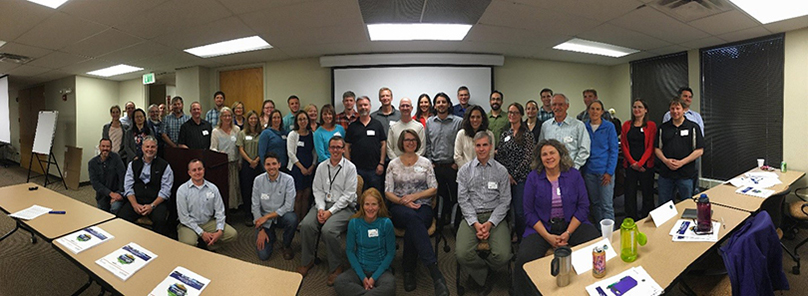
The American Association of State Highway and Transportation Officials (AASHTO) and the Federal Highway Administration (FHWA) hosted an Eco-Logical workshop for the Colorado Department of Transportation (CDOT) at the U.S. Fish & Wildlife Service (USFWS) in Lakewood, Colorado, on April 26-27, 2016. This event hosted scientists, engineers, and NEPA practitioners from all 5 regions of CDOT and focused on wildlife and transportation, specifically wildlife crossings. Presentations included topics on impacts to wildlife, wildlife crossing design options, planning and National Environmental Policy Act (NEPA) considerations, as well as the importance of agency partnerships and adaptive management activities post construction.
Workshop Facilitators and Presenters
Chuck Attardo, CDOT
Jane Hann, CDOT
Jeff Peterson, CDOT
Francesca Tordonato, CDOT
David Singer, CDOT
David Swenka, CDOT
Mike Vanderhoof, CDOT
Patricia Cramer, Utah State University
Julia Kintsch, ECO-resolutions
Pat Basting, Jacobs Engineering Group
Michelle Cowardin, Colorado Parks and Wildlife
Jason Miller, U.S. Fish & Wildlife Service
Stephanie Gibson, FHWA, Colorado Division
Dan Buford, FHWA
Mike Ruth, FHWA
Welcome
Jane Hann, CDOT, and Stephanie Gibson, FHWA Colorado Division, welcomed the workshop participants and provided an overview of the workshop agenda.
Presentation: Implementing Eco-Logical Program Overview
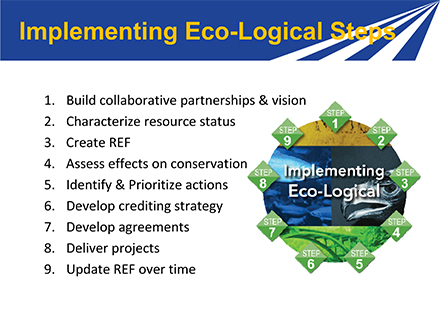
Mike Ruth, FHWA, provided an overview of Eco-Logical. Eco-Logical is a flexible, nine-step process that agencies can follow—in whole or in part. Each step helps transportation agencies and their partners move closer to landscape-scale, advance planning for better environmental outcomes, and streamlined permitting for transportation projects.
Workshop Objectives
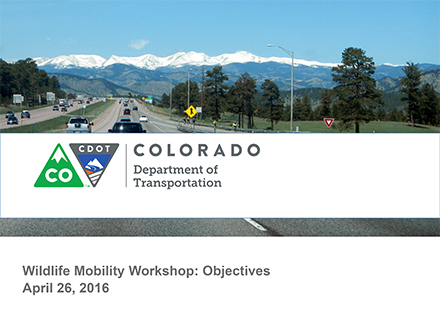
David Singer, CDOT, provided a summary of the workshop objectives. The workshop is an opportunity for CDOT biologists, engineers, NEPA practitioners and planners to learn and discuss topics about wildlife and transportation.
Presentation: Wildlife Connectivity and Crossings
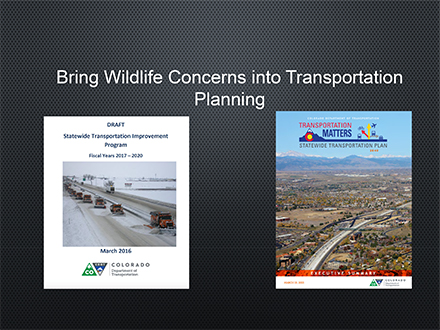
Patricia Cramer presented to the workshop participants why protected wildlife linkages and crossings need to be included as a part of the transportation planning process. She highlighted that wildlife crossing structures are becoming a part of doing business in transportation; different structure designs work; designs can be researched for efficacy and then adapted in place and inform future projects.
Presentation: Effects of Transportation on Wildlife
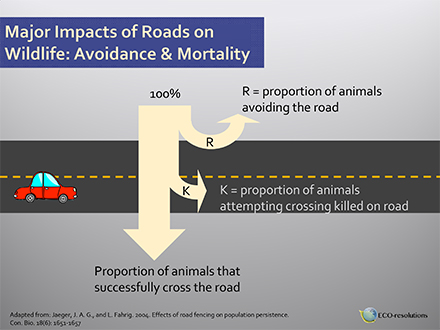
Julia Kintsch, discussed the major impacts of wildlife due to transportation, such as loss of habitat and habitat quality, wildlife mortality, and loss of habitat connectivity.
Presentation: Safety Issues and Costs Associated with Wildlife and Vehicle Collisions
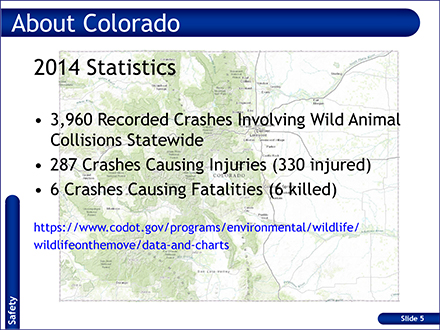
David Swenka, CDOT, presented how CDOT use safety performance tools as indicators for safety improvement prioritizations for safety programs. This presentation also compared the cost of a crash versus the cost of wildlife crossing mitigation implemented through the Highway Safety Improvement Program (HSIP).
Peer Exchange: Learn More About Your Co-Attendees’ Roles on Addressing Wildlife in Transportation
This icebreaker activity was conducted where participants worked to convince their colleagues that their role is essential to the design and delivery of wildlife crossings in Colorado.
Presentation: Species-Specific Considerations for Design
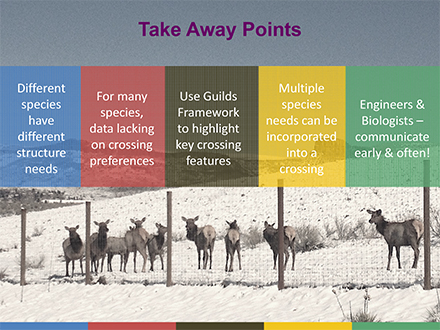
Julia Kintsch, from Eco-resolutions, provided considerations for the design of crossing structures for different species based on their attributes as obligates, generalists, or specialists. She described the conditions of their classification (openness, semi-aquatic, medium structure, large-structure, arboreal, and aerial). She explained the types of crossing structures they would most likely use based on these attributes.
Presentation: Mitigation Toolbox: Modifying Animal Behavior, Modifying Driver Behavior
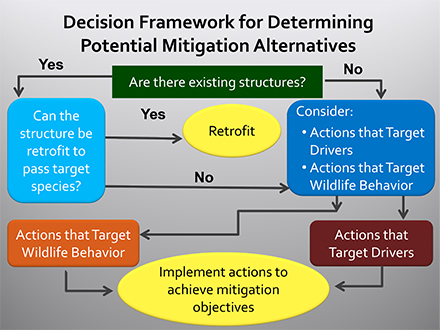
Patricia Cramer and Julia Kintsch presented opportunities and ways to retrofit existing infrastructure structures by improving them rather than building new infrastructure. Also discussed were actions, such as signage and driver warning systems that target drivers to educate and make them aware of wildlife crossings. Actions that target wildlife were also presented, i.e. different options for wildlife crossing structures, and the importance on following up on mitigation actions.
Presentation: CDOT Mitigation Approaches and Applications
A breakout session was conducted and focused on three example projects on I-70, SH-13, and US 6. Participants divided into groups and were provided an activity for one of the three example projects. For each example project, specific written or mapping information was provided for review. This included a list of species of concern, a summary of the wildlife use of the project area, wildlife vehicle collision data, traffic volume data, a summary of planned projects, a description of existing roadway infrastructure, and a summary of land ownership. Each group was requested to respond to each of the questions below.
- Identify the Problem
- What are the targets species? Listed species?
- For each target species, what is the connectivity issue and/or driver safety issue?
- What is the project scope and how will it impact target species and/or increase safety concerns?
- What are the mitigation needs of the target species?
- Identify Potential Solutions
- Which mitigation strategy or strategies would best address these impacts and meet species needs?
- Draw your solutions on the map and describe them below.
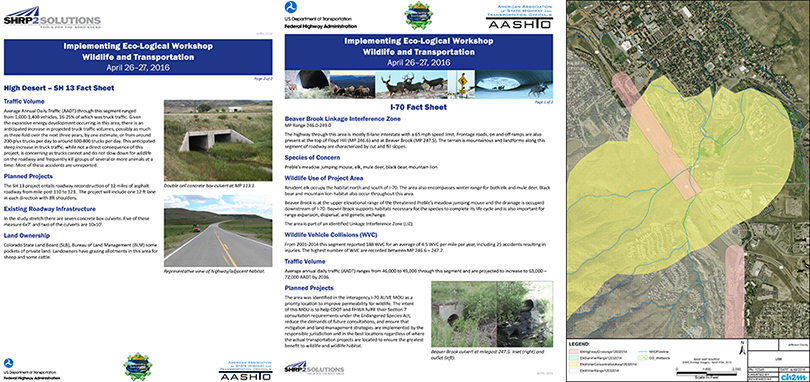
Report Out
Each group presented the results of their group discussion. Key lessons included:
- When using scenarios of high/low budget for planning, low budget planning is more complicated.
- Overpasses are more expensive up-front but easier to build so total expenses may even out.
- Consider diverting existing uses to retrofit (e.g. move pedestrian underpass to overpass).
Welcome to Day 2
Recap of Day 1; Overview of Day 2; Review of Outstanding Questions.
Presentation: Incorporating Wildlife Crossings and Eco-Logical Considerations
into Project Development and Planning Process: Part 1 - Current Process (NEPA, safety, etc.)
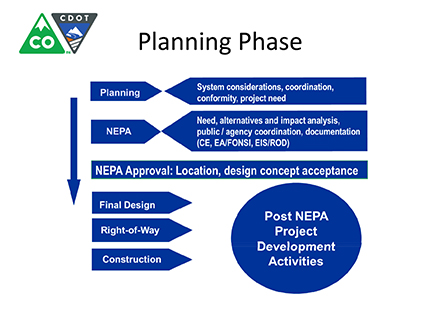
Mike Vanderhoof, CDOT and Chuck Attardo, CDOT - The presenters discussed how the incorporation of wildlife crossings and Eco-Logical considerations all start in the planning phases of transportation projects - from long range transportation plans and NEPA documentation to inclusion in transportation funding programs.
Presentation: Incorporating Wildlife Crossings and Eco-Logical Considerations
into Project Development and Planning Process: Part 2 - Lessons Learned and Future Opportunities
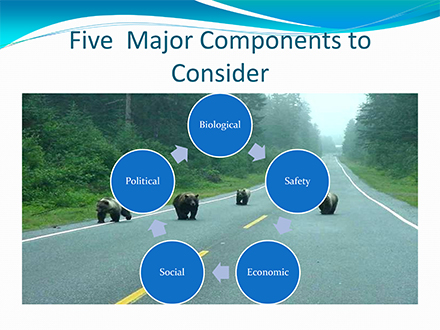
Pat Basting and Bryan Roeder, CDOT - Background information about wildlife crossing considerations in Montana were presented. A summary of the I-93 Lolo project was provided. This included retrofits of culverts for small mammal crossings. In addition, a project involving bighorn sheep on Route 220 was also discussed. Key approaches to this work were shared and include recognizing the 5 factors that influence the success of connectivity projects (biological, safety, economics, social investments, and politics), network beyond your discipline, and be a champion of the work.
Presentation: Assessing Wildlife Crossing Needs in Planning at a Landscape-Scale
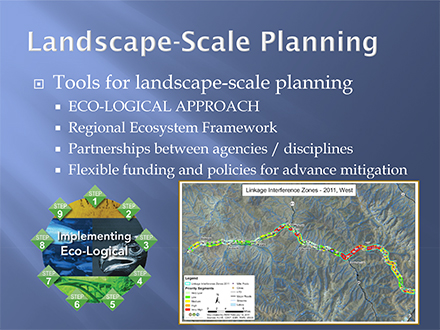
Dan Buford, FHWA - This presentation focused on the national regulator context in which wildlife crossings are driven, i.e. state wildlife laws and safety laws/policies. Landscape-scale planning and the Eco-Logical approach were presented as great tools to help agencies advance landscape-scale consideration of wildlife crossings.
Presentation: USFWS Proposed Mitigation Policy
Jason Miller, USFWS - A webinar was conducted and review the content of the Proposed Mitigation Policy.
Presentation: Applicability of Mitigation Policy to Wildlife Crossing Planning
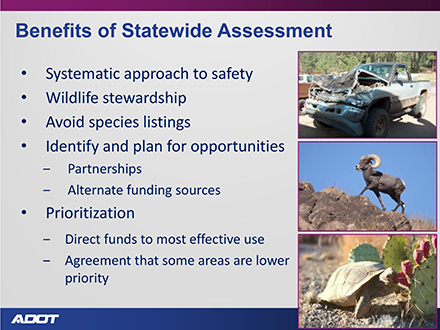
Dan Buford, FHWA - Statewide planning for habitat and population connectivity was discussed. A summary of Arizona’s Wildlife Linkage Workgroup and Assessment was provided. Background on how the partnership evolved and the content of its report were stated. Steps of the planning process were highlighted, especially about identifying opportunities, allowing the time for data collection, prioritizing projects based on funding availability, and pursuing alternate funding. Benefits of the approach included systematic approach to safety and wildlife stewardship.
Peer Exchange: Role of Partnerships
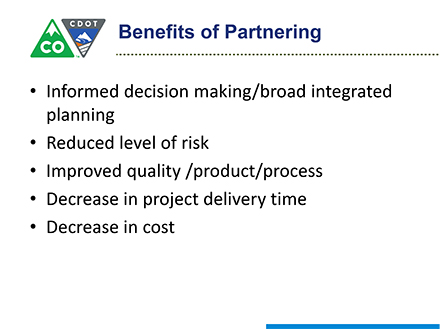
Workshop speakers discussed the importance of partnering, its benefits, and how to overcome common challenges. Case studies exhibiting the benefits of partnering were presented, including the Shortgrass Prairie Initiative, SH9 Grand County Project, I-70 ALIVE (A Landscape Level Inventory of Valued Ecosystem Components) Corridor project, and examples from Montana.
Presentation: Adaptive Management Case Studies - Nationwide
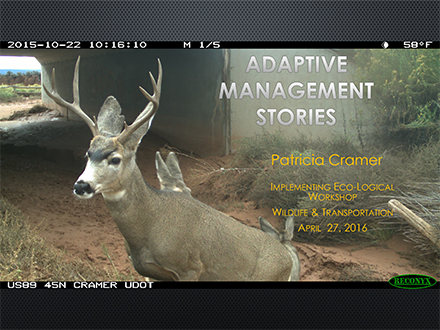
Patricia Cramer presented a case study on Utah’s US 91 in North Utah - Utah-Arizona Border Land Paunsaugunt Herd and how the project implemented strategies to ensure safe crossings after monitoring the herd’s preferences and problem areas along US 91.
Presentation: Adaptive Management Case Studies - Colorado
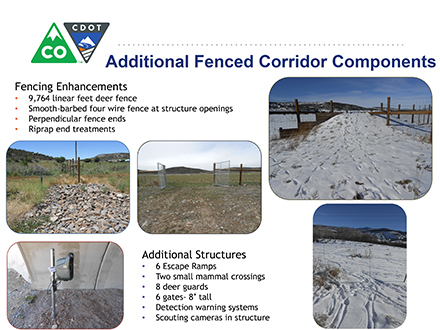
Francesca Tordonato, Julia Kintsch, and Mark Lawler discussed the US 6 At-Grade Wildlife Crossing in the city of Golden. This crossing bisects important wildlife habitat at the base of the foothills, an important transitional habitat between the foothills and the plains for deer/elk and other wildlife species.
Return to top ↑

